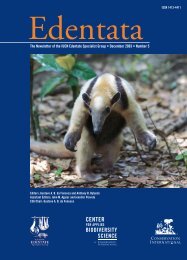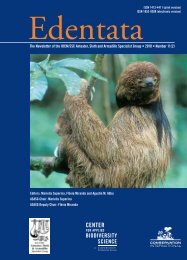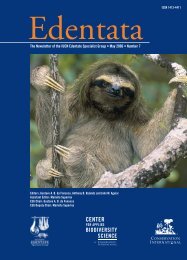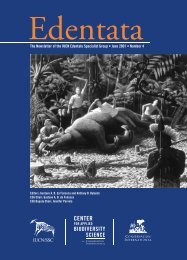Edentata 11(1) - Anteater, Sloth & Armadillo Specialist Group
Edentata 11(1) - Anteater, Sloth & Armadillo Specialist Group
Edentata 11(1) - Anteater, Sloth & Armadillo Specialist Group
Create successful ePaper yourself
Turn your PDF publications into a flip-book with our unique Google optimized e-Paper software.
Density and Habitat Use by Giant <strong>Anteater</strong>s<br />
(Myrmecophaga tridactyla) and Southern<br />
Tamanduas (Tamandua tetradactyla) in the<br />
Pantanal Wetland, Brazil<br />
Abstract<br />
Arnaud Léonard Jean Desbiez<br />
Ísis Meri Medri<br />
Giant anteaters and southern tamanduas are often<br />
sympatric throughout their range and are both found<br />
in the Pantanal wetland. Density, habitat use, selection,<br />
and habitat overlap between both species were<br />
estimated in the central region of the Brazilian Pantanal.<br />
A total of 2,174 km of transects were walked<br />
through three different landscapes and five different<br />
habitat types. Using strip transect methods, densities<br />
of giant anteaters in the study area were estimated at<br />
0.15 individuals/km², and 0.34 individuals/km² for<br />
southern tamanduas. Densities of both species were<br />
highest in forest landscapes. Southern tamanduas<br />
significantly selected the forest edge habitat. Scrub<br />
grasslands had the highest selection ratio for giant<br />
anteaters. Results from this study do not indicate<br />
that the two species partition habitat. Deforestation<br />
in the Pantanal is predicted to be detrimental to both<br />
species of anteaters.<br />
Keywords: density, giant anteaters, southern tamanduas,<br />
niche overlap, habitat use, Pantanal, wetland<br />
Introduction<br />
The giant anteater (Myrmecophaga tridactyla Linnaeus,<br />
1758) occurs from southern Belize and Guatemala to<br />
northern Argentina, while the southern tamandua<br />
(Tamandua tetradactyla Linnaeus, 1758) is found<br />
from Venezuela to northern Argentina (Nowak,<br />
1999). These species largely overlap throughout their<br />
distribution and share parts of their habitats. They<br />
occur in all biomes of Brazil (Fonseca et al., 1996)<br />
and can be found in a wide variety of habitats, ranging<br />
from open fields to dense forests.<br />
These mammals are myrmecophagous and termitophagous.<br />
In other words, they are specialized in<br />
feeding on ants and termites, which are gathered<br />
with the powerful claws of their forelimbs and the<br />
sticky, protractile tongue (Nowak, 1999). The southern<br />
tamandua is scansorial and can feed both on the<br />
ground and in trees. The giant anteater feeds mainly<br />
on the ground, but can also climb trees for feeding<br />
or for scratching, rubbing, and claw marking<br />
(Shaw et al., 1985; Rummel, 1988; Medri, 2002;<br />
Young et al., 2003; Kreutz, 2007).<br />
All members of the superorder Xenarthra, including<br />
giant anteaters and southern tamanduas, have lower<br />
body temperatures and lower basal metabolic rates<br />
than other mammals of similar body mass (McNab,<br />
1985). The giant anteater can exceed 35 kg in weight,<br />
about seven times the body mass of the southern<br />
tamandua (approximately 5 kg; Rodrigues et al.,<br />
2008). Giant anteaters and southern tamanduas display<br />
both nocturnal and diurnal activity as part of a<br />
thermoregulatory behavior to avoid exposure during<br />
the hottest or coldest hours of the day. Moreover,<br />
habitat use by these species is widely related to ambient<br />
temperature (Camilo-Alves and Mourão, 2006;<br />
Rodrigues et al., 2008). Changes in timings of activity<br />
related to ambient temperature have also been<br />
reported for armadillos (Layne and Glover, 1985)<br />
and sloths (Chiarello, 2008).<br />
Density is an important parameter to estimate population<br />
size and to monitor the status of a population.<br />
There is limited scientific literature on the population<br />
ecology of southern tamanduas and giant anteaters.<br />
Giant anteater and southern tamandua densities were<br />
estimated in Venezuela by Eisenberg et al. (1979).<br />
Data on the population density of giant anteaters<br />
in Brazil are available from the Pantanal region<br />
(Coutinho et al., 1997), Serra da Canastra National<br />
Park, Minas Gerais state (Shaw et al., 1985; Shaw et<br />
al., 1987), Emas National Park, Goiás state (Miranda<br />
et al., 2006) and Boa Vista, Roraima state (Kreutz,<br />
2007). Furthermore, Silveira et al. (1999) compared<br />
the density of giant anteaters killed by a fire in Emas<br />
National Park to the density of live individuals some<br />
months after the fire. To our knowledge, there is no<br />
scientific information available on southern tamandua<br />
density in Brazil.<br />
Our objective is to present density estimates of giant<br />
anteaters and southern tamanduas in three different<br />
landscapes of the central region of the Brazilian Pantanal<br />
and, in addition, present data on their biomass,<br />
habitat use and selection.<br />
Materials and Methods<br />
Study Area<br />
This study took place between October 2002 and<br />
November 2004 in the center of the Pantanal at the<br />
Embrapa Pantanal Nhumirim ranch and its surrounding<br />
ranches (18°59'S, 56°39'W). The study<br />
area covers over 200 km² and includes three different<br />
4<br />
<strong>Edentata</strong> no. <strong>11</strong>(1) • 2010














